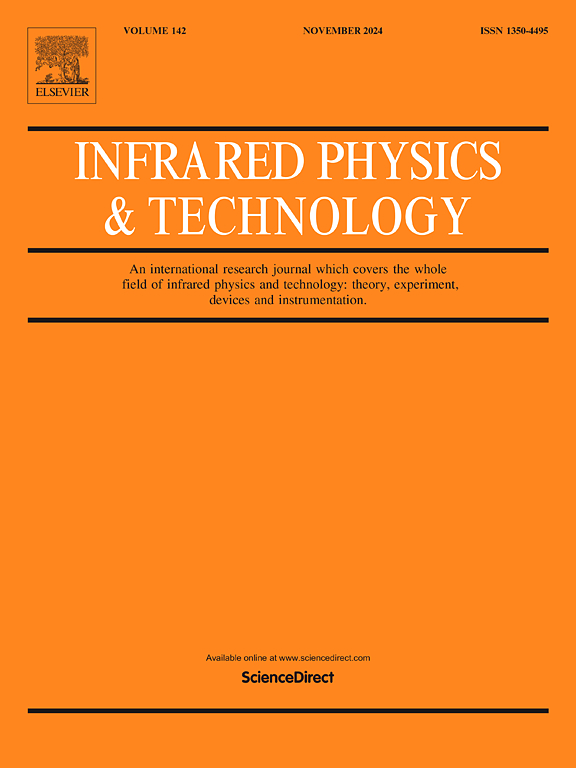用于折射率和温度传感的高灵敏度平行SPR探头
IF 3.4
3区 物理与天体物理
Q2 INSTRUMENTS & INSTRUMENTATION
引用次数: 0
摘要
为了将表面等离子体共振(SPR)传感技术推向近红外(NIR),我们提出使用TiO2半导体薄膜来调制SPR效应。结果表明,TiO2薄膜能将SPR特征波长向近红外方向移动,具有比可见光波段更高的传感灵敏度。红移的程度与半导体薄膜的厚度呈正相关。此外,本文还分析了TiO2调节SPR效应的物理机制,提出了一种并联结构的双探针传感系统。该系统的工作带宽为400-1700 nm,用于折射率(RI)和温度传感。该传感系统的仿真结果与实验结果一致。实验结果表明,该探针的特征波长在可见光范围内偏移,最大探测灵敏度为12800 nm/RIU,探测范围为1.333 ~ 1.420 RI;温度探头的特征波长在近红外波段移位,最大温度灵敏度为6.4 nm/℃,探测范围为0 ~ 100℃。测试结果还表明,该传感系统在短时间内具有良好的稳定性。利用半导体薄膜调制SPR效应的方法成功地推动了SPR传感技术向红外波段的扩展,平行探头结构突破了传统多参数传感面临的窄带限制,为光纤传感器大范围测量的研究提供了价值。本文章由计算机程序翻译,如有差异,请以英文原文为准。
High-sensitivity parallel SPR probes for refractive index and temperature sensing
In order to advance the surface plasmon resonance (SPR) sensing technique toward the near-infrared (NIR), we propose to use a semiconductor film called TiO2 to modulate the SPR effect. The results show that TiO2 film can shift the SPR characteristic wavelength to the NIR and display higher sensing sensitivity than the visible band. The degree of redshift is positively correlated with the thickness of the semiconductor film. In addition, this work analyzes the physical mechanism by which TiO2 modulates the SPR effect and proposes a dual-probe sensing system with a parallel structure. The system operates with a 400–1700 nm bandwidth for refractive index (RI) and temperature sensing. The simulation and experimental results of the sensing system show consistency. The experimental results show that the characteristic wavelength of the RI probe shifts in the visible range with a maximum RI sensitivity of 12800 nm/RIU and a detection range of 1.333–1.420 RI; the characteristic wavelength of the temperature probe shifts in the NIR with a maximum temperature sensitivity of 6.4 nm/℃ and a detection range of 0–100 °C. The test results also show that the sensing system has good stability in a short period. The method of using semiconductor film to modulate the SPR effect successfully promotes the extension of SPR sensing technology to the infrared wavelength band, and the parallel probe structure breaks through the narrow-band limitation faced by traditional multiparameter sensing, which provides value for the study of wide-range measurements of fiber optic sensors.
求助全文
通过发布文献求助,成功后即可免费获取论文全文。
去求助
来源期刊
CiteScore
5.70
自引率
12.10%
发文量
400
审稿时长
67 days
期刊介绍:
The Journal covers the entire field of infrared physics and technology: theory, experiment, application, devices and instrumentation. Infrared'' is defined as covering the near, mid and far infrared (terahertz) regions from 0.75um (750nm) to 1mm (300GHz.) Submissions in the 300GHz to 100GHz region may be accepted at the editors discretion if their content is relevant to shorter wavelengths. Submissions must be primarily concerned with and directly relevant to this spectral region.
Its core topics can be summarized as the generation, propagation and detection, of infrared radiation; the associated optics, materials and devices; and its use in all fields of science, industry, engineering and medicine.
Infrared techniques occur in many different fields, notably spectroscopy and interferometry; material characterization and processing; atmospheric physics, astronomy and space research. Scientific aspects include lasers, quantum optics, quantum electronics, image processing and semiconductor physics. Some important applications are medical diagnostics and treatment, industrial inspection and environmental monitoring.

 求助内容:
求助内容: 应助结果提醒方式:
应助结果提醒方式:


